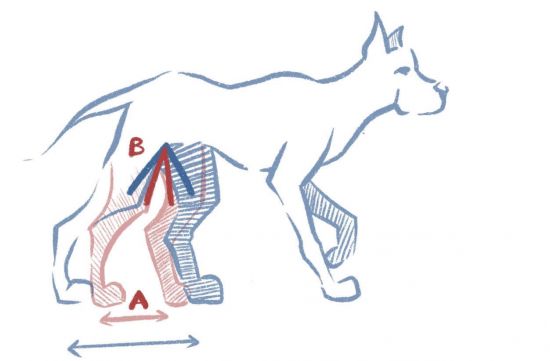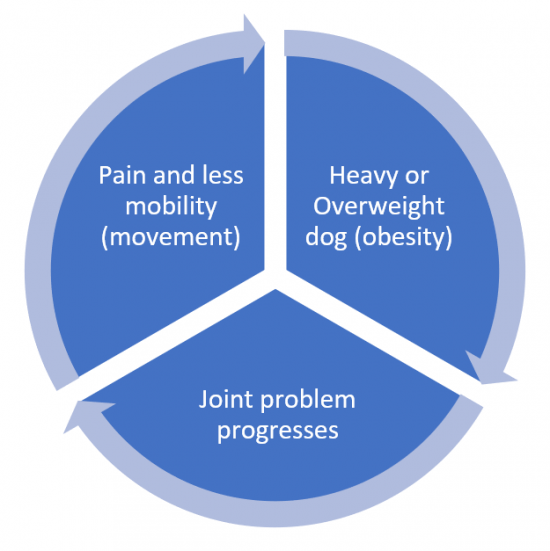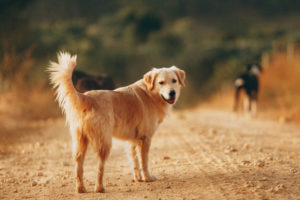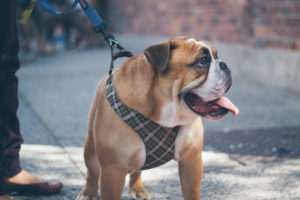Reducing the risk and severity of joint problems
Just as little as 6-8% body weight reduction has a direct influence on reducing lameness in dogs with osteoarthritis. Weight loss in overweight cats and dogs is now seen as one of the most important factors in helping pets with OA to decrease pain and improve joint mobility.
The first step to better weight management to evaluate your pets body condition. In human healthcare, they often refer to the Body Mass Index (BMI), which is a calculation to estimate body fat based on the human’s height and weight. There are also other measurements including skin fold thickness and scanners to estimate body fat percentage.
But dogs come in many different breeds and sizes, so instead, we use Body Condition Score (BCS) charts which are based on feeling (palpation) the fat level over the ribs and a visual assessment. It is scored from 1 to 9 on a scale of 9. Where 1/9 is extremely thin, 5/9 is ideal, 7/9 is overweight and scores of 8/9 or 9/9 are considered obese. There are various charts available for small, medium, large and giant breeds.
1. Brady RB, Sidiropoulos AN, Bennett HJ et al. (2013) Evaluation of gait-related variables in lean and obese dogs at a trot. Am J Vet Res 74(5):757-62.
2. Marshall WG, Hazewinkel HA, Mullen D et al (2010) The effect of weight loss on lameness in obese dogs with osteoarthritis. Vet Res Commun 34(3):241-53.
If you would like to receive regular content like this then please sign up here.
This site is protected by reCAPTCHA and the Google Privacy Policy and Terms of Service apply.
How does obesity/excess body fat negatively affect the natural movement of dogs?
When we compare how lean normal dogs walk with their overweight buddies, we see four big differences in their movement which impact the ability and mobility in dogs which carry excess body fat. They are explained here:
1. There is a shorter distance between steps (Stride length) in obese dogs.
This shorted step happens in both the front and back legs of an overweight dog as they walk. A whopping 8% shorter stride length. Overweight and obese dogs are unable to optimise their walking motion, making them shuffle (or waddle) along in short steps with more difficulty and less efficient than their lean friends. These short steps happen because of the body’s adaptive mechanism to protect the joints when there is a heavier load and in turn reduce the angle of the stride which is the angle between the two back legs (or front legs), making them inefficient movers.

The increase in body weight increases the compressive forces that pass through the joints to the ground. Blue= lean dog, Red= obese dog
2. Less joint strength (Stability) during weight bearing phase of walking.
When an obese dog is walking or trotting, there is greater force bearing down on the leg touching the ground, and this forces a greater angle (flexion) or bend in the joints, making the joints less stable. Think of it this way…….as a human, we stand on just two legs, which is obviously different to dogs, but imagine standing with a 15kg bag of rice over your shoulders and you are asked to walk. With the heavier load, your knees are likely to bend more as you walk, as they take the force of the greater weight. Unfortunately, for the dog, it’s the elbow and the hip which suffer with less stability and strength in BOTH the swing (moving leg) phase and the stance (weight bearing) phase of walking motion. The elbow and hip are the two joints which are commonly affected with ‘dysplasia’ (abnormal joint structure) in the dog and later go on to develop osteoarthritis (degenerative joint disease).
3. Increased (compressive) force to the joint causes joint structure damage faster.
You probably already guessed it…….Heavier weight results in more force pushing down to the ground through the dog’s leg. There is up to 25% more force passing through the joint in an obese dog than in a lean dog. And greater force through the joints into the ground means greater compressive forces within the joints and more stress on the joint surface and structures which includes the cartilage and bone. This overworking of the joint with abnormal forces in turn will affect the rate of osteoarthritis development and progression.

The increase in body weight increases the compressive forces that pass through the joints to the ground. Blue= lean dog, Red= obese dog
4. Unnatural spine movement also occurs with excess body weight because some of the extra weight hangs downward off the supporting spine, around the belly. Between each of the vertebrae bones which make up the spine, and protect the spinal cord, there are many little tiny joints called facet joints. These little facet joints can also suffer from osteoarthritis causing back pain- the more weight, the more pain.
Obese and overweight dogs are at high risk of diabetes, heart disease, breathing problems and joint problems (among other risks). At Paws in Motion, our big worry is the snowball effect we see with joint problems and obesity. The heavier the dog, the faster the joint problems progress. In turn, reduced mobility or movement, results in greater chance of obesity! But there is something we can do about it!

The snowball effect of the impact of obesity on joint disease progression.
Q My 11-year-old retriever-Bernese mix, Charlie, always used to walk forward in a normal fashion. But lately, I’ve been noticing that he waddles from side to side as he moves forward, kind of swinging his back in the process. It looks cute, to tell you the truth, and he doesn’t seem distressed in any way. Is this a normal part of aging? I’ve seen other dogs waddle, too.
Charlie should be kept thin — even a little thinner than average. The less weight, the less joint pressure — and the less pain.
AIt is not normal for a dog to waddle. He should be able to keep his back straight as he goes. Most often, when an older dog goes from a normal gait to a waddle, it means he has arthritis. People tend to think arthritis pain will manifest itself as a limp — that is, an uneven gait — or perhaps difficulty rising from a sitting or lying position. But if both back legs have arthritis, a dog might waddle to spare compromised joints that would cause pain if he walked straighter. A dog can actually go for years waddling before the pain reaches the point that his owner will notice his discomfort.
As for exercise, the aim is to continue it, but not with high-impact play that includes running and jumping, which jar the joints. Leash walks and swimming are two excellent possibilities. They will strengthen Charlie’s muscles, which act as shock absorbers to protect his vulnerable joints.
We should note that if it’s both front legs that are affected with arthritis, a dog might shuffle in order to cut down on the time spent on each limb. Holding up a front paw could be a sign of arthritis, too. People often think the paw is hurting when it could be the elbow or the shoulder. The dog is simply holding his limb in an unusual position to take pressure off an afflicted joint.
Hip Dysplasia in Dogs – VetVid Dog Care Video
 It is a good idea to become familiar with your dog’s normal way of moving. Get in the habit of observing your dog when it stands, sits, lies down, walks, and runs. If you notice a change in your dog’s usual movements, it might be a signal that something is hurting.
It is a good idea to become familiar with your dog’s normal way of moving. Get in the habit of observing your dog when it stands, sits, lies down, walks, and runs. If you notice a change in your dog’s usual movements, it might be a signal that something is hurting.
In a normal trotting gait for most dogs (and other four-legged animals), the dog will move forward with its back straight, supported by the in-tandem movement of the diagonal pairs of its legs. That is, the dog’s front left leg and rear right leg move at the same time to take a step forward. The next step will be the dog’s front right leg and rear left leg moving forward at the same time. The University of Minnesota College of Veterinary Medicine created a website to help dog owners understand the limb patterns of their dog’s major gaits and know what they should look like.
You may have noticed that your dog does not move with its back in a perfectly straight line. Your dog may move forward at a slight angle or slight C-shape in its back with the left or the right shoulder slightly in the lead. That is very normal and is due to the way the dog developed its most dominant pair of legs. It is similar to being right-handed or left-handed in humans.
However if you notice that your dog is no longer moving in his normal way, take notice. If your dog has begun twisting their body when they walk or run, its gait is uneven, or if its movement resembles a crab-like walk, your dog may be contorting to protect itself from pain.
Dog twisting its body or moving with a different rhythm during a walk can be a sign that your dogs has developed one of the following conditions:
One sign of spinal pain is a pacing gait, which can look as if your dog is shuffling, twisting, or rocking from side to side.
 When pacing, the dog’s diagonal pair of legs do not move in tandem. Instead, the front and rear leg on the same side of the dog’s body go forward with each step. In other words, both right legs move forward to take a step, and then both left legs move forward. Pacing can be a sign of extreme fatigue, illness, or weakness especially in the dog’s rear end. Note also that obese dogs may choose to pace rather than trot.
When pacing, the dog’s diagonal pair of legs do not move in tandem. Instead, the front and rear leg on the same side of the dog’s body go forward with each step. In other words, both right legs move forward to take a step, and then both left legs move forward. Pacing can be a sign of extreme fatigue, illness, or weakness especially in the dog’s rear end. Note also that obese dogs may choose to pace rather than trot.
Pacing is not always a sign of a problem. Some breeds, like the Old English Sheepdog, move with a pacing gait which is in fact a desirable trait. The Sheepdog and other large-breed dogs are more prone to pacing as a way to conserve energy especially when covering longer distances. Also, some dogs with short-body conformation will move in a comfortable, natural pacing gait.
If you have never noticed your dog pacing before and it has suddenly begun pacing when it walks, it is a reason to have your vet examine your dog for an injury or problem developing in the dog’s rear end or spine.
Cervical spondylomyelopathy (CSM), or wobbler syndrome, is a disease of the cervical spine (at the neck) that is commonly seen in large and giant-breed dogs. With CSM, the dog’s spinal cord and/or nerve roots are compressed in a narrowed vertebral canal which results in neurological signs and/or neck pain. Dogs with wobbler syndrome have a wobbly gait when they walk.
You should suspect your dog has wobbler syndrome if it also has any of the following symptoms along with a wobbly or twisted gait:
Your dog will need to be examined by a vet for a diagnosis and recommended treatment. In many cases, surgery is necessary to correct the condition.
An aging dog, or a dog that has recovered from a serious injury, is likely to develop arthritis. Arthritis pain will cause a dog to modify the way it moves to alleviate pain. Your dog may bob its head when it moves to reduce the weight on an arthritic limb, move stiffly to avoid pain in its joints, or contort its body in a way that minimizes pain in its movements. For these dogs, your vet may prescribe a pain reliever designed to make arthritic dogs more comfortable.